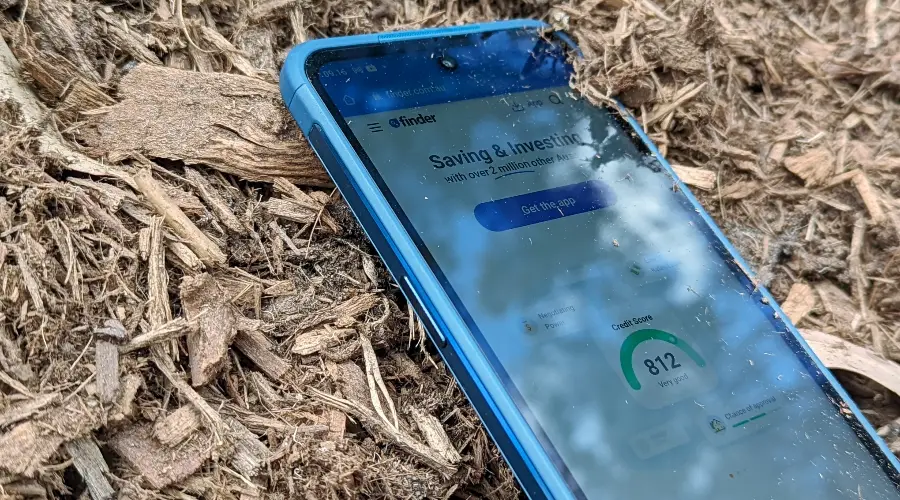Nokia XR20 review: Tough as boots, but not fast

-
- Battery Score
- Camera Score
2.5
- Design Score
4
- Performance Score
2.5
- Battery Score
Summary
Quick verdict: The Nokia XR20 is a seriously tough phone, not just in terms of its endurance but also in its general appeal. If you do need moderate Android performance in a phone that can take a serious beating though, there's nothing quite like it.
- Incredibly rugged
- Decent battery life
- 5G capable
- Underpowered for its price
- Average camera
- Poor fingerprint sensor
Details
Pricing & Availability
| RRP | $0 |
| Launch date | 2021-10 |
HMD Global, the company that holds the rights to produce Nokia-branded devices, puts out a lot of phones each year. Many of them can be hard to really distinguish. They're all generally Android One phones with 3 years of updates, many of the pricier ones feature Zeiss lenses, and they look the part of Nokia phones in design terms.
So, what's so special about the Nokia XR20? It's in the fact that it's a high mid-range-priced handset that's remarkably rugged. Truly rugged phones are a small niche, typically occupied by much more affordable fare. HMD Global's pitch is that the Nokia XR20 combines best-in-breed toughness with a more premium approach to performance.
I can't fault its toughness, and there's absolutely a market for this kind of device, but the compromises HMD Global makes along the way, especially for application performance make this a tough phone not only to break, but also to recommend.
Design: Did somebody say tough?

Image: Alex Kidman/Finder
When I first picked up the Nokia XR20, I had to work out if I was holding a rugged phone or a device that just happened to be in a rugged case. Wrapped in either "Ultra Blue" or "Granite" plastic – HMD Global provided me with the latter – it's an imposing phone, but not one that automatically says "rugged" to the naked eye.
It's not overly heavy the way some previous rugged models have been, although 248 grams isn't exactly light either. With a 6.67-inch 1080x2400 pixel LCD display it's a large unit, but the core design doesn't particularly make it stand out amongst HMD Global's many licensed Nokia handsets.
You've got to dig into the details to see precisely how tough the Nokia XR20 actually is. That front panel is comprised of Corning's Gorilla Glass Victus, and the entire unit is IP68 rated for water ingress. HMD Global rates it as good for up to 1.8 metres of drop tests, and for surviving at up to 1.5m depth of clean water for an hour. All of that sounds great, but where you get the true sense of HMD Global's confidence lies in the fact that it will replace the screen if you do manage to break it within the first year of ownership.

Image: Alex Kidman/Finder
I wasn't going to test the Nokia XR20 to the point of destruction, but I certainly had a little fun with some staged "falling down the stairs" accidents, as well as a daytime immersion in my birdbath for 30 minutes. The Nokia XR20 shrugged that off with just a little water pooling on the back of the phone, but I also learned that sulfur crested cockatoos won't go near a birdbath with a smartphone in it. Make of that what you will.
The Nokia XR20 is quite control heavy, with a combination fingerprint sensor/power button on the right-hand side sitting beneath a volume rocker. On the left there's a dedicated Google Assistant button, while the top of the phone houses a programmable emergency key that you can set for single and long press actions of your choice. The Nokia XR20 is also somewhat rare amongst its price bracket in that it has a 3.5mm headphone jack, located at the base next to its USB-C charging port.
Combination power and fingerprint sensor buttons seem to be the style choice of the day for many phones, but they do come with limitations. The smaller strike area for your finger can often lead to poor reading results, and that's a trap that the Nokia XR20 fell into rather more than I would have liked during my review time.
Camera: Zeiss lenses, but ordinary results

Image: Alex Kidman/Finder
The Zeiss branding across the rear of the Nokia XR20 plays second fiddle only to the Nokia logo on the rear of the handset, but despite some quality branding, the actual camera results were ordinary at best.
At the back, the Nokia XR20 features a primary 48MP wide sensor and secondary 13MP ultrawide sensor sitting above a dual LED flash. That's one part of the way that HMD Global manages the cost of building in all the rugged features of the Nokia XR20, because dual lens isn't exactly an exciting camera combination at this price point.

Image: Alex Kidman/Finder
It means for a start that there's no onboard true optical zoom, so you're limited to digital zoom down-sampling on that primary 48MP sensor, at up to 8x. It's not worth pushing beyond the default 2x it gives you, with frequent noise and focus issues if you push it further.
The Nokia XR20's camera app does support some interesting camera modes, including a portrait mode at the rear and for the front-facing 8MP camera. Again the lack of any focusing sensor means that it's purely using computational photography for blur effects, many of which don't look all that great.

Image: Alex Kidman/Finder
Like any mid-range 2021 handset, it's entirely feasible to get serviceable shots out of the Nokia XR20, but that's about as far as I'd say it goes.

Image: Alex Kidman/Finder
The ultrawide sensor does give you scope for landscape shots, but they're generally a touch softer and less impressive than those on the primary lens.

Image: Alex Kidman/Finder
Again, this is a phone that wants to primary sell on its rugged nature, not its camera prowess. If you're happy with that trade-off you'll be able to capture decent images, but at the price point of the Nokia XR20, you could get a much more capable camera phone.

Image: Alex Kidman/Finder
Performance: Seriously slow for its price range

Image: Alex Kidman/Finder
The Nokia XR20 sits comfortably in the upper tier of mid-range phones price-wise, so you might expect it to be packing a higher-end Qualcomm chip in the 700 or 800 ranges. Typically what you can get here are the equivalents of last year's flagship processors, and sometimes explicitly those exact chips.
That's not what lurks behind the Nokia XR20's toughened display. Instead, it features a Snapdragon 480 5G processor, something you'd typically find in the cheapest 5G handsets. It's very explicitly the price you pay for all those rugged features, because HMD Global has balanced that by dropping a lower-spec processor into the mix. It's combined with 6GB of RAM and 128GB of onboard storage, which again is very mid-range at this price point. You can at least bulk up the onboard storage with microSD cards.
The Snapdragon 480 isn't a bad processor, but it's well below what you might expect at the Nokia XR20's price point, and that shows very clearly in benchmark terms. Here's how the Nokia XR20 compares on CPU performance against a range of phones available at (or in many cases below) its asking price:
The contrast is even more stark when you pit the Nokia XR20's Adreno 619 GPU against the same phones:
The very slight saving grace here is that we've come a long way in mobile processors, and even mid-range phones can meet the needs of most users in many cases. If your handset is largely productivity and messaging focused, the Nokia XR20 will handle that well. Throw multiple apps at it, or try to run any higher level games and you'll definitely notice the difference, especially against phones with similar price points.
The Nokia XR20 is 5G capable on sub-6Ghz frequencies, and tested for me in the very typical range for 5G devices in my area. On the Telstra 5G network I hit between 200Mbps and 400Mbps down in most tests. While sub-6Ghz 5G can hit faster than that, it's very hard to say whether that's my local network coverage or the Nokia XR20 at fault.
Like its other Nokia handsets, the Nokia XR20 ships with a mostly plain Android OS onboard, but that's arguably a plus factor. It's qualified for 3 years of Android OS upgrades and security updates, so while it ships with Android 11, it should see through to Android 14 at the very least.
Nokia XR20 battery: Good but could be better

Image: Alex Kidman/Finder
The Nokia XR20 seals its battery up tight, as you'd expect from just about any phone, including those that sell on their ruggedised nature. Were you to crack it open, you'd find a 4,630mAh lithium ion battery peeking out at you. That's not the highest in this category or this price range. However, I had high hopes for the Nokia XR20, simply because using a lower-power processor should in theory give it additional battery endurance, because it's just not pushing the numbers as hard as higher-end phones.
Battery usage is always super variable, but to give it some context I ran the Nokia XR20 through Finder's standard battery test, streaming a full screen 1080p YouTube video at maximum brightness and moderate volume for an hour. Ideally what you want to see is battery life above 90% after an hour from a fully charged battery. Phones that can't manage that typically struggle to make it through a day's usage, while those that peek at 95% or better can easily sail through a day and sometimes 2 or more without issue.
Here's how the Nokia XR20 compared against that same crop of similarly priced, more powerful handsets:
In one sense, the XR20 "wins" that battle, but it's with a score that's still deeply average, and in some ways disappointing considering how much processing power you're giving up along the way. Really, I would have liked to see more here, especially as anecdotally a day was feasible but not much more. For a rugged phone you might want to take far from easy power, extra endurance would be a real plus.
The plastic back of the Nokia XR20 might suggest that you're in wired-only charging territory, but it does manage to incorporate Qi wireless charging as well, which is pleasing to see. However, it's not the fastest, with 18W wired and 15W wireless charging at most.
Should you buy the Nokia XR20?

Image: Alex Kidman/Finder
- Buy it if you want the best rugged phone money can buy.
- Don't buy it if you want performance as well as durability.
The Nokia XR20 is technically the "best" rugged phone you can buy right now, but that's a prize it really doesn't have to fight all that hard for.
There are other rugged Android options, all cheaper such as the Telstra Tough Max 3 or Aspera R9, but they're significantly less capable handsets than the Nokia XR20.
However, there's a huge trade-off here, because the Nokia XR20 is way slower than other handsets in its price range. You wouldn't quite get the same degree of protection, but you could match up many of them with ruggedised cases for a best-of-both-worlds style solution.
Nokia XR20 pricing and availability
How we tested
The Nokia XR20 was tested over a 2-week period by the author, who has been testing and reviewing phones and technology for more than 2 decades. All features, including battery life, application performance and camera quality were extensively tested. The Nokia XR20 was tested based on a review device loaned to Finder by HMD Global. As such, while it was tested for durability with multiple everyday drop and immersion tests, it was not tested to the point of breaking the actual handset.
Specifications
Display
Camera
Physical Dimensions
Connectivity
Power, storage and battery
Device features
Images: Alex Kidman
More Finder reviews
Alex Finder
Senior editor
You are about to post a question on finder.com.au:
- Do not enter personal information (eg. surname, phone number, bank details) as your question will be made public
- finder.com.au is a financial comparison and information service, not a bank or product provider
- We cannot provide you with personal advice or recommendations
- Your answer might already be waiting – check previous questions below to see if yours has already been asked
Finder only provides general advice and factual information, so consider your own circumstances, or seek advice before you decide to act on our content. By submitting a question, you're accepting our Terms Of Service and Finder Group Privacy & Cookies Policy.
This site is protected by reCAPTCHA and the Privacy Policy and Terms of Service apply.
